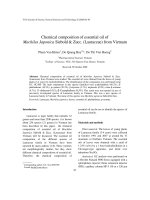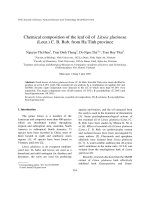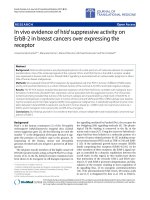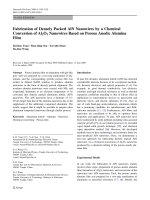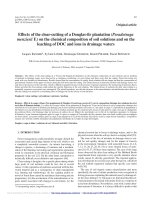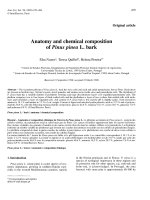Chemical composition of the essential oil of Curcuma longa and evaluation of the antifungal activity on Rhizopus stolonifer and Penicillium sp. responsible fungi for post-harvest rot of
Bạn đang xem bản rút gọn của tài liệu. Xem và tải ngay bản đầy đủ của tài liệu tại đây (329.11 KB, 12 trang )
Int.J.Curr.Microbiol.App.Sci (2019) 8(3): 797-808
International Journal of Current Microbiology and Applied Sciences
ISSN: 2319-7706 Volume 8 Number 03 (2019)
Journal homepage:
Original Research Article
/>
Chemical Composition of the Essential Oil of Curcuma longa and
Evaluation of the Antifungal Activity on Rhizopus stolonifer and
Penicillium sp. Responsible Fungi for Post-harvest Rot of
Dioscorea rotoundata in Cameroon
Evariste Josué Momo1, 2, Monique Liliane Sen1, Séverin Tchameni Nguemezi1,
Olivier Youassi Youassi1, Francis Mounbain1, Modeste Lambert Sameza1,
Franỗois Tchoumbougnang3 and Pierre Michel Jazet1*
1
Laboratory of Biochemistry, Department of Biochemistry, Faculty of Sciences,
University of Douala, PO Box 24157, Douala, Cameroon
2
School of Wood, water and Natural resources, University of Dschang,
P.O. Box 786, Ebolowa, Cameroon
3
Institute of Fisheries Science (Yabassi), University of Douala, BP: 7236, Douala, Cameroon
*Corresponding author
ABSTRACT
Keywords
Essential oil,
Curcuma longa,
Rhizopus stolonifer,
Penicillium sp.
Dioscorea
rotoundata
Article Info
Accepted:
07 February 2019
Available Online:
10 March 2019
This study focused its investigation on the use of the essential oil of a culinary and
medicinal plant commonly used in Cameroon, Curcuma longa also called red ginger for
the protection of white yam (Discorea rotoundata) during storage. The oil was obtained by
hydro distillation using Clevenger apparatus with a yield of 0.26%, the chemical
composition analysis revealed a predominance of oxygenated sesquiterpens (OST 63.43%)
with as major compound α-bisabolol (42.87%), E-β-santalol (15.3%), β-cymene (8.22%).
Fungi isolated from apparently healthy yam tubers were identified as Rhizopus stolonifer
and Penicillium sp., In vitro and in situ oil activity was evaluated. The oil completely
inhibited the growth of in vitro pathogens at 1150 and 6000 ppm respectively for Rhizopus
stolonifer and Penicillium sp., the oil being more active on Rhizopus stolonifer. In situ tests
were carried out only with this fungus. The essential oil of Curcuma longa has
significantly reduced the rot caused by this pathogen, a reduction of 87.26% and 87.8%
was obtained for the preventive and curative tests respectively. No significant difference in
activity was observed in both tests. However, there is a significant difference (P ≤ 0.0001)
in activity between the essential oil and the reference fungicide at the recommended
concentration. As concerning the activity of this essence, the red ginger essential oil could
be used as a biofungicide for the protection of yam tubers preserved against R. stolonifer,
the most formidable fungus of rot white yam in Cameroon.
crops in the world specifically in the tropics
and subtropics, especially in West and Central
Africa (APG III, 2009). About more than 600
species, the most consumed and therefore the
Introduction
Yam creeper plant belonging to the family
Dioscoreacaes, is one of the largest food
797
Int.J.Curr.Microbiol.App.Sci (2019) 8(3): 797-808
most cultivated yam is Dioscorea rotoundata
in the raison of its nutritional and organoleptic
properties. Its tuber is the food base of many
Cameroonians because of its rich starch,
mineral salts (Calcium, Phosphorus, Iron) and
because of the vitamins it contains among
others thiamine, riboflavin vitamin B and C
(Ngue et al., 2007). Its world production is
estimated at more than 60 million tons per
year, with 555647 tons per year for Cameroon
which ranks it 6th in the world. Nigeria ranks
first, followed by Ghana, Côte d'Ivoire, Benin
and Togo (Toukam et al., 2015). Despite this
important production, the white yam is
subject to several constraints during storage
including physiological and biological factors
among others. Biological factors involving
microorganisms (bacteria, viruses, fungi) are
the most recurrent, the most important attacks
are caused by fungi, the most formidable of
which are Penicillium sp., Aspergillus,
Fusarium and Rhizopus (Ogunleye et al.,
2014). The disease caused by these is known
as post-harvest rot, which affects its
production and affects its organoleptic and
nutritional properties, thus constituting a real
loss of income for the populations because
this constitutes a real source of economy for
most of them (Babajide et al., 2006). The
chemical control, which is the most used but
also the most controversial method, is based
on the use of synthetic fungicides such as
sodium orthophenylphenate, borate, captan,
thiabendazole,
benomyl,
and
sodium
hypochlorite (Foua -Bi et al., 1979; Deshi et
al., 2014). Although repeated use of the latter
has many repercussions on the health of the
populations by accumulation of residues on
the tuber and in the environment, the
resistance of several strains is also present
(Okigbo and Ogbonnaya, 2006; Deshi et al.,
2014). To remedy these shortcomings, many
researchers have turned to new methods
including biological and natural control using
useful microorganisms and natural substances
(Jazet et al., 2009). Among the natural
substances, essential oils have proven to be
the most effective because they have many
biological properties, they are biodegradable,
low toxicity and inexpensive (Otegwu, 2011,
Jazet et al., 2013, Sameza et al., 2016). The
Cameroonian flora is very biodiverse by
plants rich in essential oils like the Curcuma
longa commonly called "red ginger". It is an
herb used for its rhizome in culinary arts as
spices and condiments but more commonly as
a traditional medicine for the treatment of
certain ills in the locality. Several studies
have approved its richness in essential oil and
its biological activity as a powerful
antioxidant, antimicrobial
(antibacterial,
antiviral and antifungal) (Gianni et al., 2005,
Shiyouli et al., 2011, Záveská et al., 2012),
hence our investigation to evaluate the
antifungal potential of the essential oil of the
said plant on the fungi responsible for the
post-harvest rot of white yam (Dioscoea
rotoundata) in Cameroon.
Materials and Methods
Source of plant material
The plant was harvested in the Moungo
department in the Manjo’s city; yam tubers
with symptoms of the disease and apparently
healthy were bought at the Dakar market in
the city of Douala.
Isolation of fungi
Fungi have been isolated from yam tubers
with symptoms of the disease, according to
Koch's postulate that a fungus isolated from
the laboratory can grow on its host. It
consisted in taking from the margin of rots
fragments of tubers which were disinfected
with 70% alcohol for 1 min and then rinsed
three times with sterile distilled water, the
excess water was wrung out on blotting paper
and the fragments were inoculated into Petri
dishes containing PDA (Potatoes Dextrose
798
Int.J.Curr.Microbiol.App.Sci (2019) 8(3): 797-808
Agar)
supplemented
with
antibiotics
(penicillin 250 mg / ml and Ampicillin 250
mg / ml). The dishes were incubated at room
temperature 28 ± 2 ° C. The fungal strains
appearing were transplanted onto new
medium until pure strains were obtained. The
identification
of
fungi
focused
on
macroscopic and microscopic characteristics
according to the identification keys of Chase
et al., (2002). Macroscopic features included
staining, thallus texture and rapid growth of
the fungus, microscopic features on
vegetative and reproductive structures.
on a Varian CP-3380 GC with flame
ionization detector fitted with a fused silica
capillary column (30 m x 0.25 mm coated
with DB5, film thickness 0.25 µm);
temperature program 50°-200°C at 5°C/min,
injector
temperature
200°C,
detector
temperature 200°C, carrier gas N2, 1 ml/min.
the linear retention indices of the components
were determined relative to the retention
times of a series of n-alkanes and the
percentage compositions were obtained from
electronic integration measurements without
taking into account relative response factors.
Pathogenicity test
GC/MS analyses were performed using a
Hewlett-Packard apparatus equipped with an
HP1 fused silica column (30 m x 0.25 mm,
film thickness 0.25 µm) and interfaced with a
quadrupole detector (GC-quadrupole MS
system, model 5970). The column
temperature was programmed from 70° 200°C at 10°C/min; injector temperature was
200°C. Helium was used as the carrier gas at
a flow rate of 0.6 ml/min; the mass
spectrometer was operated at 70 eV.
The fresh tubers of yams were washed with
tap water for 20 min and then cut into a 4 cm
fragment. These fragments were treated as in
the case of isolation, then a 1 cm opening was
made in the center of minisets using a scalpel
thus allowing introducing a fungal inoculums
5 mm in diameter of a culture of 7 days, the
opening was thus closed the mini fragment
used for opening. The tuber fragments were
incubated in plastic bins with relative
humidity at room temperature (28 ± 2°C) for
10 days. After this incubation time, infection
and symptoms of tuber disease were
examined. Inoculated fragments of a PDA
disk only served as a control.
The identification of the constituents was
assigned on the basis of comparison of their
retention indices and their mass spectra with
those given in the literature (Adams, 2007)
In vitro antifungal activity of EO
Extraction and analysis of the chemical
composition of the essential oil
The antifungal activity of EO on mycelial
growth was evaluated by the agar-embedding
technique (method of nutrient poisoning) as
described by Lalhou (2004). It consisted to
dissolve the EO in dimethylsulfoxide
(DMSO) in proportions 1/9 (v / v) to obtain
10% EO stock solutions. This was done under
a laminar flow hood (LFM 8472S) and around
the flame of a Bunsen burner. The stock
solutions of EO / DMSO previously prepared
were supplemented in the superfluous culture
medium (40-50°C.) so as to obtain decreasing
concentrations of 1050, 1100, 1150 and 1175
Extraction of the essential oil was done by
hydro distillation using a Clevenger
apparatus. The excess water in the oil was
dried on a column of anhydrous sodium
sulfate (Na2SO4), the pure oil was stored in
dark bottles at 4°C.
The essential oil obtained was analysed by
gas chromatography (GC) and gas
chromatography
coupled
with
mass
spectrometry (GC/MS). The oil was analysed
799
Int.J.Curr.Microbiol.App.Sci (2019) 8(3): 797-808
ppm and of 4500, 5000, 5500 and 6000 ppm
for R. stolonifer and Penicillium sp.
respectively. The whole was homogenized
and poured into 90 mm Petri dishes at a rate
of 10 ml per dish, then a 5 mm mycelial disc
of a 1 day pre-culture for R. stolonifer and 3
days for Penicillium sp. was seeded in the
center of Petri dishes. The dishes were sealed
with paraffin and incubated in an inverted
position at 28 ± 2oC. Petri dishes containing
the PDA and the microorganism constituted
the negative control 1; whereas those, who’s
EO was replaced by DMSO constituted the
negative control 2. Those whose EO was
replaced by Bomyl (at 1000 ppm
recommended concentration) served as a
positive control. The white control contained
only the PDA and all tests were done in
triplicate. Mycelial growth was monitored by
measuring growth diameters after 3 h of time
for 1 day for isolate 1 and every 24 h for 7
days for isolate 2, thus allowing the percent
inhibition to be calculated according to
following formula: %I=((Dt-De)/Dt)x100.
%I: Percentage of inhibition; Dt (mm): Mean
diameter of mycelial growth in the negative
control box; (Mm): Mean diameter of
mycelial growth in the test box. The lowest
concentration of EO that inhibits any visible
growth of the germ is minimal inhibitory
concentration (MIC). After transplanting the
explants having exhibited a total inhibition on
the PDA medium not supplemented with the
EO, it was possible to determine the nature of
the inhibition. A regrowth considered EO
solution as fungistatic and, if not, EO solution
as fungicidal.
pathogen. Fresh yams were treated and
fragmented as described for isolation and
pathogenicity testing. The preventive test
consisting to spray the openings made on the
tuber fragments with 1000 μl of EO at fixed
concentrations from the in vitro tests carried
out, then to introduce 100 μl of a suspension
of spores of the susceptible pathogen
calibrated at 106 spores / ml, this after 1 hour
of time thus allowing the oil to be well
diffused beforehand in the cells of the tubers.
As for the curative test, it consisted of
inoculating 100 μl of spore suspension in
tuber fragments followed by the spraying of
the EO at fixed concentrations after 48 h, the
time required for the fungus to colonize the
cells tuber. The concentrations tested are:
2350, 4700, 7000 and 8000 ppm. The whole
was incubated in plastic tubs as shown in the
pathogenicity test at 28 ± 2°C for 10 days and
all tests were done in triplicate. The fragments
inoculated only by the isolates constituted the
negative control and those inoculated with
benomyl (tested at 1000 ppm recommended
concentration) positive control. The spore
suspension was prepared from the 10-day
fungal cultures; this by adjusting 10 ml of
sterile distilled water in the medium.
Calibration of the spores was done by spore
counting on microscopes in the Malassez cell.
The measurement of the diameter and height
of each rot caused by the isolates made it
possible to calculate the volume of rot
according to the formula of Masher and
Defago (2000): Vp = πr2h where Vp: volume
of rot; r: radius of rot; h: height of rot. This
made it possible to calculate the percent
reduction of rot according to the formula
presented in the in vitro tests.
Evaluation of antifungal activity in situ
It consisted to determine the antifungal
potential of the essential oil (EO) on yams
with two treatments: the preventive treatment
and the curative treatment according to the
modified protocol of Sameza et al., (2016);
however, it was made on the most sensitive
Statistical analysis
The data was analyzed by Stat view software
version 5.0 for Windows (SAS, Institute, Inc.,
USA). The ordered analysis of the variance
(OANVA) was used to compare mean values
800
Int.J.Curr.Microbiol.App.Sci (2019) 8(3): 797-808
between several groups (n ≥ 2). Subsequently,
Fisher's Pair Least Significant Difference
(PLSD) test was used to compare two by two
if the OANVA result was significant. The
threshold of significance was set at p-value
<0.05.
(15.3%), β-cymene (8.22%), Methyleudesmate (6.95%) and γ-terpinene (4, 75%).
These results have similarities but also
differences with those of some authors. This
is the case, for example, of the work of
Husain et al., (1992) who found a
predominance of sesquiterpenes
with
germacrene, bisabolol and guainane as the
major compounds. In addition, Sharma and
Tripathi, (2006) during their analysis obtained
atlantone, 1,8 cineole and -phellandrene as
major compounds. Li Shiyou et al., (2011)
demonstrated
a
predominance
of
monoterpenes in the leaves of the plant and
sesquiterpenes for the dried rhizomes
responsible for their taste and smell. They
identified 54 bisabolans, 6 germacrene, 7
guainanes, 4 selinans, 3 santalanes, 2
caryophillene, 2 elamanes, the aristolene, the
bergamotanes, the carabane, the cedrane, the
himachalene as a group of major compounds.
Gianni et al., (2005), on the other hand,
obtained significant amounts of
tumerone (19.82% and 35%) and richness in
monoterpenes such as
-phelllandrene
(20.4%), 1.8-cineole (10,3%) and terpinolene
(6.19%).
Results and Discussion
Extraction yield and Chemical composition
of the essential oil
The essential oil of our plant is of pale yellow
color, of lower density than that of water
(0.92) with a yield of 0.27%. This result is
lower than that of Souhila and Souhila (2014)
who obtained a yield of 0.96% after
hydrodistillation extraction of the powders of
the same plant harvested in the region of
Tlemcen (Algeria). It is the same for Li
Shiyou et al., (2011) who had obtained a yield
of 1.5 to 5% from the dried rhizomes of this
plant. They reported that the yield of fresh
rhizomes ranged from 0.16% to 1.94%,
interval in which ours is included. The
differences in levels of essential oil of C.
longa would be due to several factors such as
geographical origin, ecological factors
including climate factors (temperature and
humidity), plant organ, stage of growth,
collection period, the conservation of the
plant material, the method of extraction and
the type of treatment undergone by the organ.
These differences observed in the chemical
composition of the essential oil from the same
species could be due to the ecological
conditions undergone by the plant, to the
variety of the plant, somehow to intrinsic and
extrinsic factors (Massoti et al., 2003, Pibiri,
2005). These differences could also show the
existence of a significant number of
chemotypes of this species. Indeed,
chemotypes of the same botanical species
make it possible to obtain EOs of different
chemical compositions (Pibiri, 2005).
After analysis of the chemical composition of
the oil, 30 compounds were eluted (Table I).
In general, we have a small proportion of
monoterpenes
(19.37%)
compared
to
sesquiterpenes (74.50%). Likewise, the
hydrocarbon monoterpenes (14.53%) are
superior to the oxygenated monoterpenes
(4.84%).
Moreover,
oxygenated
sesquiterpenes (64.56%) are predominant
compared to hydrocarbon sesquiterpenes
(9.94%). Thus, 5 major compounds were
noted: α-bisabolol (42.87%), E-β-santalol
Antifungal activity of the essential oil
Our oil has inhibited the different pathogens
significantly. Petri dishes showed a decrease
in growth diameter as the concentration of
801
Int.J.Curr.Microbiol.App.Sci (2019) 8(3): 797-808
essential oil was high in both pathogens.
Thus, the activity of the oil was inversely
proportional to the growth diameter of the
pathogens (Figure 1).
Table.1 Chemical composition of the essential oil of Curcuma longa
N°
KI
1
2
3
4
5
6
933
984
1005
1022
1053
1083
7
8
9
10
11
1030
1182
1239
1275
1304
12
13
14
15
16
17
18
19
1377
1408
1430
1469
1475
1488
1504
1718
20
21
22
23
24
25
26
27
28
29
30
1561
1586
1630
1658
1685
1738
1767
1783
1786
1805
1853
Chemical compounds
Monoterpenes
Hydrocarbon monoterpenes
α-pinene
β-pinene
D-3-carene
P-cymene
ϒ-terpinene
terpinolene
Oxygenated monoterpenes
1,8-cineole
cis-pinocarveol
carvone
isopulphyl acetate
terpinyl acetate
Sesquiterpenes
Hydrocarbon Sesquiterpenes
α-copaene
α-carophyllene
β -carophyllene
z-β-farnesene
α-humulene
cis-β-guaene
β-bisabolene
methyleudesmate
Oxygenated Sesquiterpenes
(E)-nerolidol
glunol
α-eudesmol
α -muurolol
α-bisabolol
E-β-santalol
cedryle acetate
tetradecenol
α -cadinène
farnesyl acetate
benzyl benzoate
KI = Kovats index; NI = Not identified
802
Percentage(%)
19.37
14.53
0.28
0.52
0.42
8.22
4.75
0.34
4.84
2.59
1.38
0.28
0.34
0.25
74.50
9.94
0.43
0.26
0.27
0.29
0.76
0.68
0.3
6.95
64.56
0.75
0.86
1.03
0.53
42.87
15.3
0.6
0.83
0.98
0.42
0.39
Int.J.Curr.Microbiol.App.Sci (2019) 8(3): 797-808
Fig.1 Curve of evolution of the growth diameter of the two pathogens in the presence of the
essential oil. A: on R. stolonifer; B: on Penicillium sp.
A
B
Fig.2 Percent inhibition of essential oil on both pathogens based on concentrations
803
Int.J.Curr.Microbiol.App.Sci (2019) 8(3): 797-808
Fig.3 Percentage of rot reduction caused by R. stolonifer based on essential oil concentrations
The coloration observed was also change
during the growth of the fungi in the medium
supplemented with essential oil compared to
the control contained only the culture medium
and the pathogens. With Rhizopus stolonifer,
the mycelium became very transparent with
no elevation of the latter. Growth remained
flat; while with Penicillium sp., the color has
changed from greenish to yellow. However,
although our oil inhibited the growth of
Penicillium sp. at higher concentrations than
Rhizopus stolonifer, it should be noted that
inhibition diameters in Penicillium sp. were
much lower than that of R. stolonifer (Figure
1). The calculation of the percentage
inhibition after measuring the growth
diameters allowed us to obtain total inhibition
corresponding to the MIC at 1175 and 6000
ppm for R. stolonifer and Penicillium sp.
respectively. After transfer of the fungal
explants corresponding to the MIC in new
culture medium, our oil proved to be
fungicidal for both pathogens. Figure 2
illustrates the inhibition percentages as a
function of EO concentration. This inhibition
increases as the concentration of EO is high.
Thus, it will be said that the activity of the EO
is proportional to the concentration. Several
studies have reported the activity of C. longa
on pathogens of medical as well as food this
would therefore justify the activity obtained
with our pathogens; this is the case of Souhila
and Souhila (2014) who evaluated the activity
of this oil on two plant parasitic fungi:
Boirytis cinerea and Fusarium oxysporum.
They obtained an inhibition diameter of 20
and 21.83 mm for the two pathogens
respectively at the dose of 10 and 20 μl of
EO; However, Gurdip et al., (2008) found
33.97% and 26.76% inhibition for this oil on
two kinds of aflatoxin-producing fungi on
food; Aspergillus and Penicillium at
concentrations of 10000 ppm and 6000 ppm
respectively. R. stolonifer being more
sensitive than Penicillium sp., in vitro activity
of the oil was evaluated only on the latter. A
significant reduction of rot volume was
observed on tuber fragments treated with
essential oil compared to the untreated
control. Inhibition of 87.26% against 87.80%
respectively in the preventive and curative
tests was obtained at 8000 ppm (Figure 3).
Fisher's post hoc doc test did not show any
significant difference (P 0.0001) between
both treatments performed on minisets of
tubers; similar results are expected for both
tests with benomyl. However, at 4700 ppm a
reduction of 83.89% and 83.8% respectively
was obtained for both tests, similar activity
with the reference fungicide which reduced
by 82.65% and 82.5% respectively. From the
activity of benomyl to the recommended
804
Int.J.Curr.Microbiol.App.Sci (2019) 8(3): 797-808
concentration, there is a significant difference
in action (P 0.0001) with our oil at 8000 ppm,
the oil being more efficient.
species. Disturbance of this matrix can result
in a defective wall, which becomes sensitive
to osmotic lysis and sensitive to antifungal
agents such as essential oils among others
(Yen and Chang, 2008). In most cases, the
mycelium cells no longer have a cytoplasm or
have a depleted cytoplasm of organelles. The
color characteristic of many molds has been
shown to be due to conidium pigmentation
(Wiley, 2005). As a result, the color change of
both pathogens after application of C. longa
essential oil may also be due to its effect on
conidium. Similarly it has been found that
essential oils can cause morphological
changes including insufficient sporulation,
loss of pigmentation, abnormal development
of conidiophores and deformation of hyphae
(Rasooli and Abyaneh, 2004, Sharma and
Tripathi, 2006). Reducing the amount of rot
before or after applying our essential oil
would have had an effect on the inhibition of
enzymatic reactions caused by fungi, thus
allowing starch degradation; constituent
elements of yam tubers in essential molecule
for their development which is glucose.
The activity of the essential oil of the studied
plant would be justified by its chemical
composition, our oil being rich in terpene
compounds (MTH and MTO). Many
researchers have shown that terpenes and
their oxygenated derivatives are the main
components of essential oils. These
compounds have a high inhibitory potential
on pathogenic microbial strains like fungi
(Hossain et al., 2008, Sameza et al., 2016).
Minor constituents of essential oils especially
could also be involved in antifungal activity
(Bajpai et al., 2010, Jazet et al., 2013). Thus,
the compounds corresponding to the majority
of EO products are not necessarily more
effective than the oils themselves. Thus, the
compounds corresponding to the majority of
HE products are not necessarily more
effective than the oils themselves. The
mechanism of action of essential oils against
mold is not fully understood until now. But
some authors have given several suppositions
according to their observations. Most studies
report their effects on cell membranes. In fact,
the active compounds attack the cell wall and
membrane, thereby affecting the permeability
and release of intracellular constituents, also
interfering with membrane function (Rasooli
and Owlia 2005, Pinto et al., 2006, Carmo et
al., 2008, Koul et al., 2008, Bajpai et al.,
2008, Bajpai and Kang, 2010). In view of the
sensitivity of R. stolonifer to our species
compared to that of Penicillium sp., it can
also be deduced that the active principle of
HE lies in their majority constituents and that
the sensitivity of the strains to a given HE
differs according to the genus and the species,
as it may vary according to other criteria. This
is justified by the nature of the wall of fungal
strains which consists of a complex network
of proteins and polycarbohydrates and which
varies in composition according to the fungal
In conclusion, the rhizome of the red ginger
plant has revealed richness in essential oil,
with
for
chemical
composition
a
predominance of OST compared to HST. This
oil significantly inhibited the growth of
pathogens in vitro and significantly reduced
the rot caused by Rhizopus stolonifer in both
tests (preventive and curative). Thus the
essential oil of Curcuma longa could be used
as a biofungicide to preserve white yam
tubers from post-harvest rot in our locality.
References
Adams R.P., 2007; Identification of essential
oil
components
by
gas
chromatography mass spectrometry.
Illinois: Allured Publishing: Carol
Stream, IL, USA: 495.
APG III, 2009; An update of the Angiosperm
805
Int.J.Curr.Microbiol.App.Sci (2019) 8(3): 797-808
Phylogeny Group classification for the
orders and families of flowering
plants. Botanical Journal of the
Linnean Society. 161: 105–121.
Babajide J.M., Oyewole O.B. and Obadina
O.A., 2006; An assessment of the
microbiological safety of dry yam
(Gbodo) processed in south west
Nigeria.
African
Journal
of
Biotechnology. 5: 157-161.
Bajpai V.K. and Kang S.C., 2010. Antifungal
activity of leaf essential oil and
extracts
of
Metasequoia
glyptostroboides Miki ex Hu. J. Am.
Oil. Chem. Soc. 87: pp. 327-336.
Bajpai V.K., Shukla S. and Kang S.C., 2008.
Chemical composition and antifungal
activity of essential oil and various
extract
of
SilenearmeriaL.
Bioresource Technology 99: 8903
8908.
Carmo E.S., Lima E.D.O. and De Souza E.L.,
2008; The potential of Origanum
vulgare L. (Lamiaceae) essential oil in
inhibiting the growth of some foodrelated Aspergillus species. Brazilian
Journal of Microbiology 39:362-367.
Chabasse D., Bouchara J. P., De Gentile L.,
Brun S., Cimon B. and Penn P., 2002.
Les dermatophytes. Cahier de
formation n° 31, Biopharma. 158p.
Deshi S. N., Wonang D. L. and Dafur B. S.,
2014; Control of rots and spoilage of
Agriculturalproducts:
a
review.
International Letters of Natural
Sciences. 18:63-72.
Foua B.I., Babacauh K. and Demeaux M.,
1979. Pertes sur les ignames au cours
du stockage: causes et méthodes de
lutte. In: La conservation des denrées
alimentaires cultivées en climat chaud
et humide. Actes du premier colloque
international de technologie (CIT),
Yaoundé 5(10): 395-412.
Gianni S., Silvia M., Mariavittoria M.,
Martina S., Stefano M., Matteo R. and
Renato B., 2005; Comparative
evaluation of 11 essential oils of
different
origin
as
functional
antioxidants,
antiradicals
and
antimicrobials
in
foods.
Food
Chemistry. 91: 621–632
Gurdip S., Kapoor I.P., Pratibha S., Carola S.
H., Marina P. L. and Cesar A.N.,
2008; Chemistry, antioxidant and
antimicrobial
investigations
on
essential oil and oleoresins of Zingiber
officinale. Food and Chemical
Toxicology. 46: 3295–3302.
Husain, A., Virmani, O. P., Popli, S. P.,
Misra, L. N., Gupta, M. M.,
Srivastava, G. N. Abraham, Z. and
Singh, A. K., 1992; Dictionary of
Indian Medicinal Plants. CIMAP,
Lucknow, India.546p.
Jazet Dongmo P. M., Tatsadjieu N. L.,
Sameza B., Ndongson D. B., Amvam
Z. P. H. and Menut C., 2009;
Propriétés antifongiques des huiles
essentielles de quelques plantes du
genre Aframomum au Cameroun
contre Aspergillus flavus. Cameroun
Forum for Biological Science 5(1):
44-51.
Jazet D. P. M., Tchoumbougnang F., Fekam
B. F., Tchinda S. E., Amvam Z. P. H.
and Menut C., 2013; Antiradical,
antioxidant activities and antiinflammatory potential of the essential
oils of the varieties of citrus limon and
citrus aurantifolia growing in
cameroon. Journal of Asian Scientific
Research. 3(10): 1046-1057.
Koul O., Walia S. and Dhaliwal G.S., 2008;
Essential oils as green pesticides:
potential and constraints. Biopestic.
Int. 4(1): 63–84.
Lahlou M., 2004; Methods to study the
photochemistry and bioactivity of
essential oils. Phytotherapy Research.
1: 435-448.
Li Shiyou; Yuan, Wei; Deng, Guangrui;
806
Int.J.Curr.Microbiol.App.Sci (2019) 8(3): 797-808
Wang, Ping; Yang, Peiying; and
Aggarwal, Bharat, 2011; "Chemical
composition and product quality
control
of turmeric
(Curcuma
longaL.)". Faculty Publications. Paper
1.
Masotti V., Juteau F., Bessière J.M. and
Viano J., 2003; Seasonal and
Phenological Variations of the
Essential Oil from the Narrow
Endemic Species Artemisia molinieri
and Its Biological Activities. Journal
of Agricultural and Food Chemestry.
51 (24): 7115–7121.
Ngue Bissa T., Mbairanodji A. and Njualem
D., 2007. Guide des techniques de
production and de conservation
d’ignames
(Dioscoreaspp).
Programme
National
de
Développement des Racines et
Tubercules (PNDRT): 35.
Ogunleye, Akin O., Ayansola and Oyeronke
T., 2014. Studies of Some Isolated
Rot-Causing Mycoflora of Yams
(Dioscorea Spp.). American Journal
of Microbiology and Biotechnology.
1(1): 9-20.
Okigbo, R. N. and Ogbonnaya U. O., 2006;
Antifungal effects of two tropical
plant
leaf
extracts
(Ocimumgratissimum
and
Aframomummelegueta)
on
postharvest yam (Dioscorea spp.) rot.
African Journal of Biotechnology 5
(9): 727-731.
Otegwu T. C., 2011; Activities of some
antifungal
agents
against
phytopathogenic yam rot fungi spores
in zaria, Nigeria. A Thesis of Master
of
Science
in
Pharmaceutical
Microbiology.
Faculty
of
Pharmaceutical Sciences, Ahmadu
Bello University Zaria, Kaduna,
Nigeria. 139p
Pibiri, M. C., 2005; Assainissement
microbiologique
de
l’ai
and
dessystèmes de ventilation au moyen
d’huiles essentielles. Thèse de
doctorat, ộcole polytechnique fộdộrale
de Lausanne. 161p.
Pinto E., Pina-Vaz C., Salgueiro L.,
Gonỗalves M.J., Costa-de-Oliveira S.,
Cavaleiro C., Palmeira A., Rodrigues
A. and Martinez-de-Oliveira J., 2006;
Antifungal activity of the essential oil
of Thymus pulegioides on Candida,
Aspergillus and dermatophyte species.
Journal of Medical Microbiology, 55,
1367–1373.
Rasooli I. and Abyaneh M.R., 2004.
Inhibitory effect of Thyme oils on
growth and afltoxin production by
Aspergillus parasiticus. Food Control,
15, 479-483.
Rasooli
I.
and
Owlia
P.,
2005.
Chemoprevention by thyme oils of
Aspergillus parasiticus growth and
aflatoxin production. Phytochemistry,
66, 2851-2856.
Sameza M. L., Mabou N. L., Tchameni S. N.,
Bedine B. M., Tchoumbougnang F.,
Jazet D. P. and Fekam B. F., 2016;
Evaluation of Clove Essential Oil as a
Mycobiocide
Against
Rhizopus
stolonifer and Fusarium solani, Tuber
Rot Causing Fungi in Yam (Dioscorea
rotundata
Poir.).
Journal
of
phytopatology. 164: 433–440,
Sharma N. and Tripathi A., 2006; Effects of
Citrus sinensis (L.) Osbeck epicarp
essential oil on growth and
morphogenesis of Aspergillus niger
(L.) Van Tieghem. Microbiology
Research, 163: 337–344.
Sherwin E.R., 1976; Antioxidants for
vegetable oils. Journal of American
Oil Chemical Society, 53,430-436.
Souhila L. and Souhila R., 2014; Etude de
l’efficacité huiles essentielles de
curcuma longa comme biopesticide
cas antifongique. Mémoire présenté
pour l’obtention du diplôme de
807
Int.J.Curr.Microbiol.App.Sci (2019) 8(3): 797-808
Magister en Amélioration de la
Production Végétale. Université Abou
Bekr Belkaïd-Tlemcen (Algérie). 81p.
Toukam G.M.S., Siadjeu C., Bell J.M.,
Nkwate S. and Bomda J., 2015;
Influence de quelques caractères
agronomiques sur le rendement de
l’igname
sucrée
(Dioscorea
dumetorum Kunth Pax) au Cameroun.
International Journal of Biological
Chemistry. 9(1): 141-154.
Wiley J., 2005; Essential microbiology.
Southern Gate, Chichester, West
Sussex PO19 8SQ, England, 481p.
Yen T-B., and Chang S-T., 2008; Synergistic
effects
of
cinnamaldehyde
in
combination with eugenol against
wood decay fungi. Bioresource
Technology, 99, 232-236.
Záveská E., Fér T., Šída O., LeongŠkorniĉková J., Sabu M. Et Marhold
K, 2012; Genetic diversity patterns in
Curcuma reflect differences in
genome size. Botanical Journal of the
Linnean Society. 165, 388-401.
How to cite this article:
Evariste Josué Momo, Monique Liliane Sen, Séverin Tchameni Nguemezi, Olivier Youassi
Youassi, Francis Mounbain, Modeste Lambert Sameza, Franỗois Tchoumbougnang and Pierre
Michel Jazet. 2019. Chemical Composition of the Essential Oil of Curcuma longa and
Evaluation of the Antifungal Activity on Rhizopus stolonifer and Penicillium sp. Responsible
Fungi
for
Post-harvest
Rot
of
Dioscorea
rotoundata
in
Cameroon.
Int.J.Curr.Microbiol.App.Sci. 8(03): 797-808. doi: />
808
